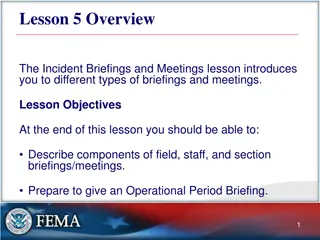Cyber Incident Response Planning and Team Organization
This comprehensive incident response planning companion provides guidelines for creating effective policies and plans, emphasizing the importance of customization to suit each agency's unique circumstances. It outlines the purpose, objectives, and structure of an incident response plan, along with the roles and responsibilities of the Cyber Incident Response Team. By following the Prepare, Identify, Contain, Respond, Eradicate, Recover, and Follow-Up framework, organizations can mitigate the impact of security incidents and maintain operational resilience.
Download Presentation

Please find below an Image/Link to download the presentation.
The content on the website is provided AS IS for your information and personal use only. It may not be sold, licensed, or shared on other websites without obtaining consent from the author.If you encounter any issues during the download, it is possible that the publisher has removed the file from their server.
You are allowed to download the files provided on this website for personal or commercial use, subject to the condition that they are used lawfully. All files are the property of their respective owners.
The content on the website is provided AS IS for your information and personal use only. It may not be sold, licensed, or shared on other websites without obtaining consent from the author.
E N D
Presentation Transcript
Incident Response Planning Companion Use this along with sample incident response plan word document.
The following Incident Response Plan is intended to provide an example of how a policy and plan can be written. It is not intended to cover all possible situations. Each agency must evaluate their unique circumstances and incorporate those into their plan. The plan is not intended to be a fill in the blank plan. If an agency chooses to simply fill in the blanks, the plan may not be sufficient to cover the agency s unique requirements during a security incident and could potentially cause the agency additional harm. Disclaimer Please share your plan and experiences with colleagues to help improve these tools.
Prepare Identify Contain Responding to an Incident Eradicate Recover Follow Up
Purpose Protect Our Information assets Provide a central organization to handle incidents Comply with requirements and regulations Prevent the use of our systems in attacks against other systems (which could cause us to incur legal liability) Minimize the potential for negative exposure. Objectives Limit immediate incident impact to customers and partners Recover from the incident Determine how the incident occurred Find out how to avoid further exploitation of the same vulnerability Avoid escalation and further incidents Assess the impact and damage in terms of financial impact, loss of image etc. Update policies and procedures as needed Determine who initiated the incident Document al information, events, and efforts to provide to law enforcement Cyber Incident Response Team
Organizing for Incident Response
Our Cyber Incident Response Team Role Responsibilities Primary/Alternate(s) Cyber Incident Response Management Will have overall responsibility for directing activities in regard to the incident at Severity Level 2 and above. Will serve in advisory capacity for incidents at Severity Level 1. Coordinates external assistance as required. Provides oversight to incident response. Requests resources as required to effectively contain and manage an incident response. Documents incident for purposes of law enforcement, lessons learned, and insurance. Provide technical aspects of incident response. Cyber Incident Response Coordinator Cyber Operations Team / Technical Operations Team Communications / Media Team Responsible for internal, external and media communications Extended Technical Team Provides additional technical skill and capability to the Technical Operations team as required (ie. outside vendor or agency) Provides requested administrative support. Admin Support Extended Team Provide additional visibility and support to incident response as required. Provide specific HR, legal, finance, etc. skills as required.
How this really works in a small organization One Person Team More than 1
Additional Team Members DATA OWNERS DEPARTMENT LEADERSHIP SUBJECT MATTER EXPERTS
Our Extended Team Michigan State Police Cyber Command Center MC3 MC3@Michigan.gov 877-MI-CYBER MC3@Michigan.gov MC3@Michigan.gov Add contact info here Cyber Insurance Provider Critical Systems IT Vendors Add contact info here
Incident Categories Severity Level 0 (Low) Description Incident where the impact is minimal. Examples are e-mail SPAM, isolated Virus infections, etc. Incident where the impact is significant. Examples are a delayed ability to provide services, meet our mission, delayed delivery of critical electronic mail or data transfers, etc. Incident where the impact is severe. Examples are a disruption to the services, and/or performance of our mission functions. Our proprietary of confidential information has been compromised, a virus or worm has become widespread, and is affecting over 1% of employees, Public Safety systems are unavailable, or our Executive management has been notified. 1 (Medium) 2 (High) 3 (Extreme) Incident where the impact is catastrophic. Examples are a shutdown of all our network services. Our proprietary or confidential information has been compromised and published on a public site. Public safety systems are unavailable. Executive management must make a public statement.
Incident Escalation and Team Activation Escalation Level Low Affected Team(s) Description Technical Operations Team Cyber Operations Team Technical Operations Team Cyber Operations Team Cyber Incident Response Coordinator Cyber Incident Response Management Cyber Incident Response Management Cyber Incident Response Coordinator Technical Operations Team Cyber Operations Team Extended Technical Team Communications / Media Team Cyber Incident Response Management Cyber Incident Response Coordinator Extended Team Technical Operations Team Cyber Operations Team Extended Technical Team Communications / Media Team Administrative Support Team Normal Operations. Engineering and cyber groups monitoring for alerts from various sources. Our organization has become aware of a potential or actual threat. Determine defensive action to take. Message employees of required actions if necessary. o o o o o o o o o o o o o o o o o o o o Medium A threat has manifested itself. Determine course of action for containment and eradication. Message employees of required actions if necessary. High Threat is widespread or impact is significant. Determine course of action for containment, mitigation and eradication. Message employees. Prepare to take legal action. Prepare to make public statement. Severe
3.5 Cyber Incident Response Team Roles and Responsibilities 3.5.1 Escalation Level 0 ii. Technical Operations Team / Cyber Operations Team 1.Monitors all known sources for alerts or notification of a threat. 2.Take appropriate defensive actions per known issues. 3.Escalate to Cyber Incident Coordinator if determined that Severity level may be greater than Level 0. iii. Cyber Incident Coordinator 1.Escalate Cyber Incident Response to Level 1 if information is received that the incident is likely greater than Level 0. Incident Escalation Roles and Responsibilities 3.5.2 Escalation Level 1 INSERT AGENCY NAME HERE has become aware of a potential or actual threat. i. Technical Operations Team / Cyber Operations Team 1.Determine initial defensive action required. 2.Notify the Cyber Incident Coordinator. 3.Determine appropriate course of action. ii. Cyber Incident Coordinator 1.Receive and track all reported potential threats. 2.Start a chronological log of events. 3.Escalate Cyber Incident Response to Level 2 if a report is received indicating that the threat has manifested itself. 4.Determine relevant membership of the Technical Operations and Extended Technical teams. 5.Alert other IT personnel and applicable support organizations of the potential threat and any defensive action required. 6.Alert Cyber Incident Response Management of the potential threat. Seek advisory inputs as appropriate. 7.Alert Communications Team iii. Cyber Incident Response Management 1.Provide advisory inputs as appropriate. Use Section 3.5, Appendix B, and Threat Examples to help teams and team members understand their roles and responsibilities at each incident level. Walk-through may also help clarify team membership. iv. Communications Team 1.If employee action required, message employees of required action.
Special Circumstances Identify reporting requirements for reporting breach of confidential information. How will you communicate if email and/or phones systems are offline or compromised? For instance HIPAA, CJIS, FERPA, and others have strict reporting requirements. Develop alternative and offline communication methods now. Assemble report templates now.
Post Incident Cyber Incident Coordinator and Response Management Estimate of damage/impact, Action taken during the incident (not technical detail), Follow on efforts needed to eliminate or mitigate the vulnerability, Policies or procedures that require updating, Efforts taken to minimize liabilities or negative exposure. Provide the chronological log and any system audit logs requested by the Extended Team, Document lessons learned and modify the Cyber Incident Response Plan accordingly. Extended Team Legal and Finance work with the local authorities as appropriate in the case that the incident was from an external source. HR and IT work with *Our Organization* management to determine disciplinary action in the case that the incident was from an internal source. Law Enforcement, Homeland Security leveraged to support as necessary.
Continuous Improvement Conduct table-top exercises. Conduct live or semi-live incident scenarios. Refine the plan to make it your own. Ask for help from your peers. Share back with the Cyber Partners community. Volunteer to be part of the group that will help refine this. Present this at a conference in 2020.























